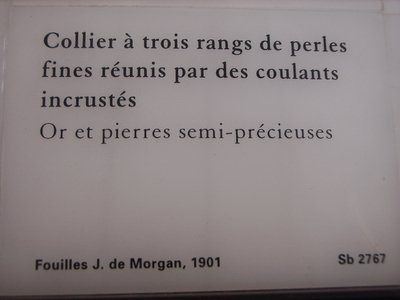|
Pearls in Ancient Egypt
 Pearl Necklace in Louvre J. de Morgan
So far as can be determined from the representations of ancient Egypian costumes, pearls in ancient Egypt do not seem to have been employed to any great extent in their decoration. The necklaces, earrings, and other jewels found in the tombs, which are composed largely of gold set with crystal gems, contain the remains of a few pearls in ancient Egypt, but give no indication that they were numerous. In fact, no evidence exists that they were used extensively before the Persian conquest in the fifth century B.C.; and probably it was not until the time of the Ptolemies that there began the lavish abundance of pearls in ancient Egypt which characterized the court of Alexandria at the height of her power.  Section of Ancient Pearl Necklace found by J. de Morgan
The Egyptians of olden times do not appear to have used fine pearls in ancient Egypt, although they probably knew of them on account of the proximity of the Red Sea. M. J. de Morgan, the explorer, says: "In the tombs of Dashour I have never seen any; the only ones that I know of in Egyptian jewelry belong to the Ptolemaic period and are mounted in Greek style.1 This statement is confirmed by Dr. William F. Petrie, the well-known Egyptologist, who writes under date of July 26, 1907: "The pearl was often used in Roman jewelry in Egypt, but I do not know of any instance of it in pure Egyptian work. The Romans pierced it and hung it by gold wire on earrings. They also made glass, pearl-like beads, called luli by the modern natives. These beads are made by silvering glass beads and the flashing over them another coat of glass."  Pearl Necklace found by J. de Morgan
Among specimens of the pearls in ancient Egypt we may note here some objects in the Louvre: A pleasing decoration on gold wire is a necklace in the collection of the Egyptian Gallery. In this very small pearls in ancient Egypt are used as a connective decoration for the points of leaves, and to hold the leaves and ornaments is a gold wire which is secured by bending. This piece comprises 104 pearls, a greater number than is contained in any other object of antiquity found in Egypt.  Ancient Pearl Necklace in Louvre Museum An Egyptian pendant of unknown origin is also shown in this collection. At the lower end is a bull's head, caparisoned, and the tip of each horn is fitted with a ball like the embolados toros of the Spanish bull-fights. The rein is double, and above this there are two roundelles of an unidentified material; then comes a rondelle of lapis lazuli, and after this a rondelle of gold. The whole is strung with twisted gold wire. The center stone is an hexagonal amethyst, evidently a crystal, the two faces of which had been poished and incised. One of these faces represents a priest with a staff of office, and the other a priest holding an incense-burner with the hieroglyph of the alter. With one hand he is offering the two sacrifices, the mineral and the vegetable; in the other he holds a garland of flowers or leaves. Above this is an Oriental pearl somewhat wron and abraded. All these are secured by a twisted gold wire, to which four tiny gold beads of graduated size are affixed at the top of the pendant.  Louvre Description of Pearl Necklace found by J. de Morgan
There are six other pendants and earrings in the Egyptian Gallery, all of which contain pearls, and in most instances these pearls have been drilled and suspended by metal wires, unless they are used as an ornament facing outward. In four instances they are secured by a peg of gold. 1"Delegation en Perse," Pris, 1905, Vol. VIII, p.52.

|











